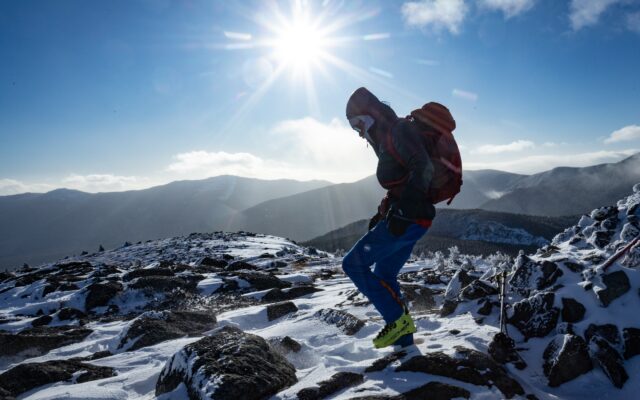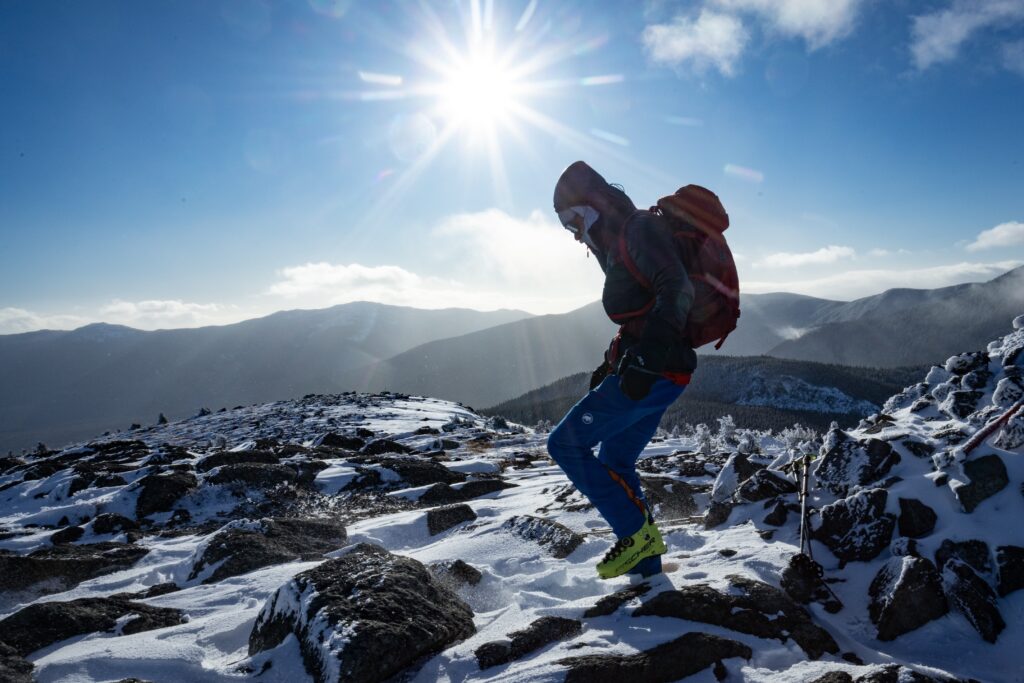
What I’ve learned about hiking in extreme cold
By Aislinn Sarnacki
Gusts of freezing wind threatened to bowl us over as we emerged from the shelter of snow-caked trees. We were entirely exposed to the elements on the bare summit of Burnt Mountain, and Mother Nature wasn’t messing around.
The recorded wind chill was minus 35 degrees Fahrenheit. It was dangerous, even though we were both prepared.
In such extreme conditions, the two of us couldn’t remain out in the open for long. Ice crystals danced in front of our eyes, twinkling in the sun. To the west, snow swirled off the steep slope of Sugarloaf Mountain. The harsh beauty was mesmerizing.
Crouched behind a summit rock pile, we escaped the worst of the wind. Yet I could feel the cold sneaking in, finding its way through layers of wool and fleece and down. After just a few minutes, we retreated, following our bootprints back to the frozen forest.

EXTREME COLD HIKE — Chris Bennett hikes over the barren summit of Burnt Mountain on Jan. 5, a day when the reported wind chill is as low as -35 degrees Fahrenheit.
We knew it was going to be alarmingly cold that day based on the weather reports. So my friend Chris and I dressed warmly and checked in on each other throughout the hike.
“How are your hands?” “How are your toes?” “Do you still want to go above the treeline?”
We packed bottles of hot water protected by insulated sleeves, which were a godsend mid-hike. There are few situations where warm water can be described as “wonderful,” and a hike up a snowy mountain is one of them.
I wore my thickest mittens. Yet, at times, the tips of my fingers burned with the cold. Uphill exertion helped warm my body, and that warmth eventually spread to my hands and feet. But then I had to worry about sweating.
When hiking in the cold, it’s best to sweat as little as possible because that moisture cools your body down quickly when you slow down or stop for a break. In preparation for this issue, I packed a wool shirt that I could change into if I became too sweaty.
It takes a lot of energy to stay warm, so we packed extra snacks. And as usual, we carried survival gear.
So what was our true danger on Burnt Mountain?
Hypothermia was our primary concern. This is when your body temperature drops low enough that things stop working properly, and this can rapidly lead to death.
Early signs of hypothermia are shivering and clumsy movements. But the scary thing, to me, is one of the next symptoms: confusion. People developing hypothermia often can’t think straight, so they make mistakes and don’t recognize the danger they’re in. That’s one of the many reasons it’s safer to hike with a companion or two.
Our other concern was frostbite, which is when skin freezes due to exposure to the cold. This can cause damage, and in extreme cases, it can cause the tissue to die.
The interesting thing about frostbite is that there isn’t an exact temperature or set of conditions that cause it. Usually a person won’t develop frostbite until the air temperature is well below freezing because the body generates so much heat. But studies have shown that as temperatures drop and the winds pick up, the risk of developing frostbite increases dramatically.
Common areas of the body for frostbite are fingers, toes and the face. In an effort to protect myself, I wore insulated boots, ski goggles and a balaclava.
Being an outdoorsperson is a process. The more time spent outdoors, the more you learn, either through observation, study, experiences or mistakes.
At one point during our hike, I noticed Chris whipping his arm around like he was pitching a softball. I asked what he was doing, and he explained that the movement helped warm up his fingers. This windmill motion helps restore circulation to your fingers by forcing blood outward.
I tried out his trick, and it worked. In just a few seconds, my fingers started to tingle and warm up.
Of course, you can’t windmill your arms forever. It’s only a temporary fix. That’s why it’s important to wear warm enough clothing and carry emergency tools for warming up like chemical hand warmers, extra clothing and materials for starting a fire.
Another trick for staying warm is to drink lots of water. This thins your blood and therefore improves circulation.
The most important method of staying warm that I’ve found is to keep moving. If you must stop to have a snack or drink water, then make it a short break. Make sure you’re out of the wind. Pile on an extra jacket. If you must sit down, sit on your backpack rather than the cold ground. And to prevent snacks from freezing, carry them in a pocket next to your body.
But all the preparation in the world may not be enough to protect against extreme weather. That’s why it’s crucial to know your route, listen to the needs of your companions and be flexible to turning around early or altering your plans.
While resilience and persistence certainly have a place in outdoor adventure, rash stubbornness and pride do not, and a fine line separates those states of mind.
The cold deserves respect. To some degree, you can protect yourself from it. But sometimes, the best thing to do is descend the mountain and seek shelter.